Welcome to Lean Marketing
What has changed in marketing over the past five years? It seems that literally everything: the struggle for conversion has intensified, rates in the context are growing, the situation in the channels of attraction is constantly changing, the tools for the marketer are complex and there are many, the customer is demanding, he changes his wishes and is always there. As a result, the timing and results are increasingly unpredictable. Simply put, we look at the picture and agree:
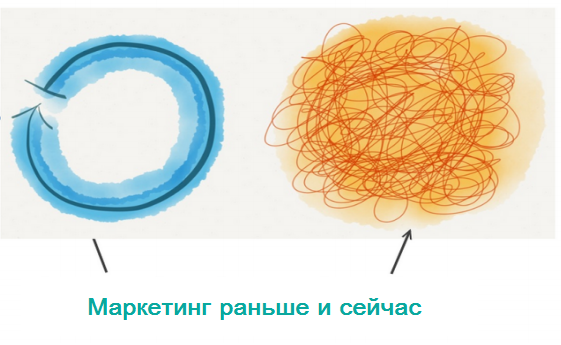
How to build the work process of the marketing team when the external working conditions are so unpredictable and change so often? What new process management methodologies are worth applying?
To answer this question, you need to remember what other processes in IT companies have become so complicated that they required the introduction of new methodologies? The first thing that comes to mind is development. Previously, there was enough waterflow, but now serve Scrum, Kanban, XP, etc.
Let us turn to the Cynefin framework to clarify the situation. Judging by the model, any processes can be divided into Simple, Complex, Confused, Chaotic, and all this is visualized as follows:
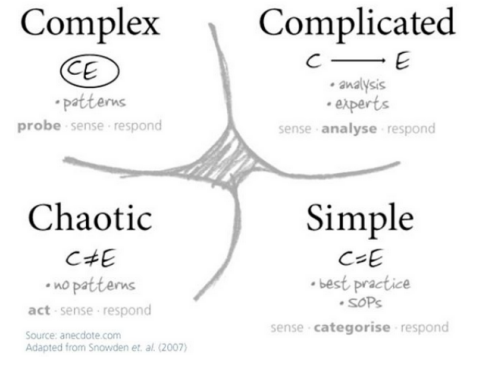
It is generally accepted that the upper left zone (Complex) is the Agile zone. The complexity of programming processes, such as changing customer requirements, the uniqueness of each solution, increased risks and costs, is a consequence of weak ties between the customer, the contractor, and consumers, which flexible methodologies try to solve through short iterations, retrospectives, etc. The
second example is business. There was a time when a business opened with a carbon copy, according to a business plan. The slogan of zero: "Do something high-quality and the market will eat it." But competition is growing, all niches are occupied, to pierce the market you need to look for something fundamentally new. Get literally out of the chaos of ideas (lower left zone) a new confusing business model and, through the search for repetitive practices (upper left zone), do a day-to-day business (upper right zone).
It is very difficult to create a business and even maintain an existing one. As in Alice through the Looking Glass: "... you have to run as fast just to stay in the same place." Business moved from the Complicated to Complicated process, as a result of which the principles, methodology, authorities, textbooks changed, the need for new institutes (incubators, accelerators) appeared.
Similar processes, but with a little delay, occur with marketing, and first of all, with Internet marketing. Too many changing external factors in marketing force to completely change internal marketing processes.
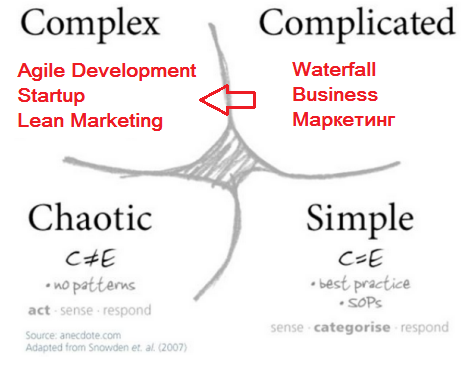
What is so inside an intricate zone? What are the principles?
Reminds me of Lean Startup by Eric Rees? Experiments, hypotheses, the search for repetitive practices. It is Lean Startup that is the source of inspiration for Lean Marketing, but first things first.
In 2010, the book “Data-Based Marketing ...” by Mark Jeffrey was published, in which the author strongly recommends putting customer behavior data at the center of everything and using 15 key marketing indicators to measure and improve marketing performance. Mark also talks about the challenges that marketers face when analyzing data. The main message of the book:
2011. Eric Rhys in The Lean Startup: ... offers a completely new concept for bringing products and services to market. If we discard the motivational thesis that the entrepreneur lives in each of us, then the concept of Lean Sturtup made an outstanding book.
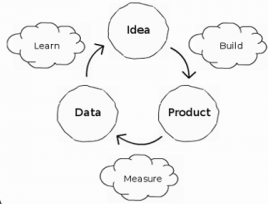
In 2012, they first formulated the principles of agile marketing at the SprintZero: The Physics of Agile Marketing summit and called it Agile Marketing Manifesto (again, by analogy with the manifesto of the developers of Manifesto for Agile Software Development ).
2012-2014 years. A series of books from different authors, but with proofreading by Eric Ries (Eric Ries). This is often a very successful attempt to apply the principle of “create-evaluate-learn” (Build, Measure, Learn) for the lean development of the client, user interface, corporations and even the brand.
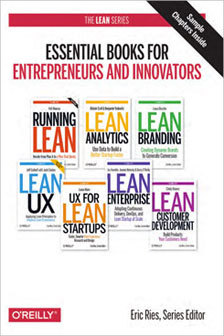
So, on the one hand, marketing is becoming more complicated every day and with the help of old management textbooks it’s no longer possible to unravel the tangled tangle of marketing tasks. On the other hand, the processes in startups are very similar and there is a new understanding of how to act, based on flexible methodologies.
As a result, we see the birth of new marketing - Lean Marketing based on Lean Startup by Eric Rhys. I will try to give a definition as close as possible to the Lean Startup concept:
How do you like it? Vote for this definition or give your option, a link in the comments. Let's already decide what lies ahead)
How to introduce Lean Marketing in the company I will describe in the following posts.

How to build the work process of the marketing team when the external working conditions are so unpredictable and change so often? What new process management methodologies are worth applying?
To answer this question, you need to remember what other processes in IT companies have become so complicated that they required the introduction of new methodologies? The first thing that comes to mind is development. Previously, there was enough waterflow, but now serve Scrum, Kanban, XP, etc.
Let us turn to the Cynefin framework to clarify the situation. Judging by the model, any processes can be divided into Simple, Complex, Confused, Chaotic, and all this is visualized as follows:

Simple - the interconnections in these systems are obvious to any rational person, the causal relationships in these systems are also clear and are on the surface.
Complicated - there are causal relationships, but they are not so obvious anymore and it is hard for a non-expert to understand them.
Confused (Complex) - cause-effect relationships cannot be detected in advance, even with serious analysis. They will become clear only after the event has occurred and it will be possible to build a retrospective.
Chaos (Chaotic) - no causal relationship. Nothing is clear. It is impossible to draw any conclusions. Chaos is a temporary condition. Complete chaos in nature exists for a very short time and only as a kind of transitional state.
It is generally accepted that the upper left zone (Complex) is the Agile zone. The complexity of programming processes, such as changing customer requirements, the uniqueness of each solution, increased risks and costs, is a consequence of weak ties between the customer, the contractor, and consumers, which flexible methodologies try to solve through short iterations, retrospectives, etc. The
second example is business. There was a time when a business opened with a carbon copy, according to a business plan. The slogan of zero: "Do something high-quality and the market will eat it." But competition is growing, all niches are occupied, to pierce the market you need to look for something fundamentally new. Get literally out of the chaos of ideas (lower left zone) a new confusing business model and, through the search for repetitive practices (upper left zone), do a day-to-day business (upper right zone).
It is very difficult to create a business and even maintain an existing one. As in Alice through the Looking Glass: "... you have to run as fast just to stay in the same place." Business moved from the Complicated to Complicated process, as a result of which the principles, methodology, authorities, textbooks changed, the need for new institutes (incubators, accelerators) appeared.
Similar processes, but with a little delay, occur with marketing, and first of all, with Internet marketing. Too many changing external factors in marketing force to completely change internal marketing processes.

What is so inside an intricate zone? What are the principles?
In intricate systems, we begin to build hypotheses and create all kinds of experiments in order to confirm or dispel these hypotheses. For each sane point of view or theory that has arisen, we create an experiment or a series of experiments. These experiments do not have to be successful, but they must provide insights and add understanding to what is happening. Experiments can run in parallel and contradict each other.
There is no best or good practice in this area. Practices arise here as experiments are conducted.
Reminds me of Lean Startup by Eric Rees? Experiments, hypotheses, the search for repetitive practices. It is Lean Startup that is the source of inspiration for Lean Marketing, but first things first.
History Lean Marketing
In 2010, the book “Data-Based Marketing ...” by Mark Jeffrey was published, in which the author strongly recommends putting customer behavior data at the center of everything and using 15 key marketing indicators to measure and improve marketing performance. Mark also talks about the challenges that marketers face when analyzing data. The main message of the book:
“80% of companies do not use data-driven marketing. The remaining 20% become leaders. ”- Mark JeffreyIt was this book that created Data-Driven Marketing. I will try to give the following wording for DDM:
Data-Driven Marketing is a type of marketing where ALL marketing decisions and actions are based on data about users and their behavior.
2011. Eric Rhys in The Lean Startup: ... offers a completely new concept for bringing products and services to market. If we discard the motivational thesis that the entrepreneur lives in each of us, then the concept of Lean Sturtup made an outstanding book.

Lean Startup is a concept of an iterative approach to the development and launch of new products on the market, while constantly eliminating all types of losses and maximizing value for the consumer, until the resources are exhausted.By the way, the “create-evaluate-learn” cycle (Build, Measure, Learn) is an analogue of the sprint in Scrum's flexible programming methodology.
In 2012, they first formulated the principles of agile marketing at the SprintZero: The Physics of Agile Marketing summit and called it Agile Marketing Manifesto (again, by analogy with the manifesto of the developers of Manifesto for Agile Software Development ).
Agile Marketing Manifestation
Training instead of opinions and conventions.
Customer-oriented collaboration instead of hierarchy.
Adaptive and iterative campaigns instead of voluminous and complex.
Opening customers instead of static forecasting.
Flexible planning instead of hard.
Reaction to changes instead of following the plan.
Many small experiments instead of one large.
2012-2014 years. A series of books from different authors, but with proofreading by Eric Ries (Eric Ries). This is often a very successful attempt to apply the principle of “create-evaluate-learn” (Build, Measure, Learn) for the lean development of the client, user interface, corporations and even the brand.

- Running Lean By Ash Maurya January 2012 Running Lean in Russian
- Lean UX By Jeff Gothelf February 2013
- Lean Analytics By Alistair Croll, Benjamin Yoskovitz March 2013
- UX for Lean Startups By Laura Klein May 2013
- Lean UX Workshop By Jeff Gothelf April 2014
- Lean Customer Development By Cindy Alvarez May 2014
- Lean Branding By Laura Busche September 2014
- Lean Enterprise By Jez Humble, Barry O'Reilly, Joanne Molesky December 2014
Conclusion
So, on the one hand, marketing is becoming more complicated every day and with the help of old management textbooks it’s no longer possible to unravel the tangled tangle of marketing tasks. On the other hand, the processes in startups are very similar and there is a new understanding of how to act, based on flexible methodologies.
As a result, we see the birth of new marketing - Lean Marketing based on Lean Startup by Eric Rhys. I will try to give a definition as close as possible to the Lean Startup concept:
Lean Marketing is a type of marketing in which the ongoing process of eliminating all types of losses and maximizing value for the consumer is launched using the iterative “create-evaluate-learn” approach and constant communication with the client.
How do you like it? Vote for this definition or give your option, a link in the comments. Let's already decide what lies ahead)
How to introduce Lean Marketing in the company I will describe in the following posts.
Only registered users can participate in the survey. Please come in.
What is Lean Marketing?
- 66.6% Lean Marketing - a type of marketing in which the ongoing process of eliminating all types of losses and maximizing value for the consumer is launched using the iterative “create-evaluate-learn” approach and constant communication with the client. 14
- 9.5% wrote their option in comments 2
- 23.8% don't see the point in Lean Marketing 5
